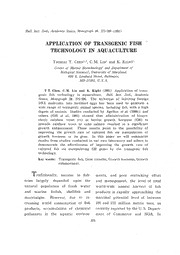
APPLICATION OF TRANSGENIC FISH TECHNOLOGY IN AQUACULTURE PDF
Preview APPLICATION OF TRANSGENIC FISH TECHNOLOGY IN AQUACULTURE
Bull. Inst. Zool., Academia Sinica, Monograph 16: 375-386 (1991) APPLICATION OF TRANSGENIC FISH TECHNOLOGY IN AQUACULTURE THOMAS T. CHEN1,2, C. M. LIN1 and K. KIGHT1 Center of Marine Biotechnology! and Department of Biqlogical Sciences2 University of Maryland, , 600 E. Lombard Street, Baltimore, MD 21202, U.S.A. T T. Chen, C. M. Lin and K. Kight (1991) Application of trans genic fish technology in aquaculture. Bull. Inst. Zool., Academia Sinica, Monograph 16: 375-386. The technique of injecting foreign DNA nlolecules into fertilized eggs has been used to generate a wide range of transgenic animal species, including fish, with a high degree of success. Studies conducted by Agellon et ale (1988c) and others (Gill et at., 1985) showed that administration of biosyn thetic rainbow trout (rt) or bovine growth hormone (GH) to juvenile rainbow trout or coho salmon resulted in a significant growth enhancement. Thene results point to the possibility of improving the growth rate of cultured fish via manipulation of growth hormone or its gene. In this paper we will summarize results from studies conducted in our own laboratory and others to demonstrate the effectiveness of improving the growth rate of cultured fish via manipulating GH genes by the transgenic fish technology. Key words: Transgenic fish, Gene transfer, Growth hormone, Growth enhancement. Traditionally, success In fish ments, and poor restocking effort eries largely depended upon the and management, the level of total natural population of fresh water world-wide annual harvest of fish and marine finfish, shellfish and products is rapidly approaching the macroalgae. However, due to In maximal potential level of between creasing world consumption of fish 100 and 150 million metric tons, as products, accumulation of chemical recently reported by the U. S. Depart pollutants in the aquatic enVlron- ment of Commerce and NOA. In 375
